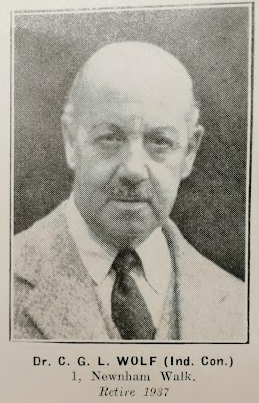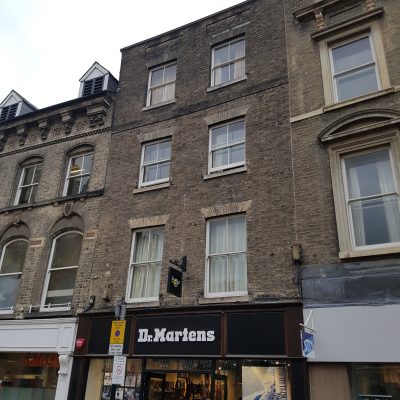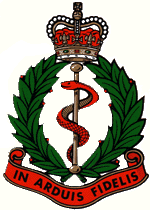Search by topic
- archaeology
- Building of Local Interest
- chapel
- charity
- church
- crime
- dressmaker
- fire
- Great Eastern Railway
- Listed building
- Mapping Relief
- medieval
- oral history
- poverty
- Public House
- Religious House
- Roman
- scholar
- school
- Then and Now
- tudor
- women
- work
- world war one
- world war two
Search by text
 1936, Blue Book
1936, Blue BookNewnham Walk
History of Newnham Walk
Next to the surgery is The Pightle, originally owned by St John’s College. In 1864, the College granted the house as its first 99-year lease in the Newnham area to one of its Fellows, Professor George Liveing, a chemist and spectroscopist, who subsequent became President of the College and was still living there in 1922-23. In the 1886 Ordnance Survey map, it is shown as having a large garden which included most of what is now Wordsworth Grove plus a narrow strip of land that extended to what is now Church Rate Walk. The next occupant was Dr Charles George Lewis Wolf, a biochemist at Addenbrooke’s Hospital. The house was acquired by Newnham College in 1945.
See 3, Summerfield, Cambridge
Newnham Walk not listed in Mathieson’s Director of Cambridge in 1867
1874 (Spalding’s)
1887
1895
(3)
No.3 Newnham Walk (which is also No.1 Wordsworth Grove) appears in the 1901 Ordnance Map but not in the 1885 map. The land on which it was built was sold in 1897 by St Catharine’s College to St John’s College, and was then leased in 1901 to William Sindall, a builder, who built the house and lived in it. It was subsequently leased to Dr Hugh Scott (1920), to His Honour Judge Henry Gatchell Farrant102 (1921), to Professor W.B.R. King (1943), and to Sir Rudolph Albert Peters and Miss Gwendoline Peters (1955). Following Sir Rudolph Peters’s death, Dr Hermann Hauser and Dr Pamela Raspe in 1982 purchased the lease from his widow Lady Frances Williamina Peters, and then in 1984 acquired from St John’s College (the ground landlord) the land on which the house was built.
During the First World War, No.3 was used by the Red Cross as an auxiliary hospital: one of over 3,000 such hospitals across the country. Thus in Spalding’s for 1915, it is listed as “First Borough Red Cross Hospital”. It was linked to the First Eastern General Hospital (Territorial Force). Philomena Guillebaud’s history of this general hospital, From Bats to Beds to Books, describes how in 1914 the Army requisitioned what had previously been the sports field of Clare and King’s Colleges (the “bats” of the title) to build a military hospital (the “beds”) on what later became the site of the University Library (the “books”). She notes that “the rapid influx of ill and wounded necessitated expanding facilities for convalescents to free up beds for the newcomers, and in rapid succession Red Cross and other auxiliary hospitals came into being to meet these needs”. By the end of 1915 there were a number of them, including – in addition to Wordsworth Grove – one in Cheshunt College in Bateman Street, and others in surrounding villages such as Linton, Histon, Fulbourn, Cottenham and Shepreth, usually located in large private houses. The patients at the auxiliary hospitals were generally less seriously wounded than at the military hospitals and needed to convalesce; servicemen tended to prefer them because they were not so strict, were less crowded, and the surroundings were more homely. An audiotaped interview with Joan Lydia Lush, a British nurse who had read Classics at Newnham College, and served with the Red Cross in Cambridge between May 1915 and November 1918, refers to her being recruited by a Newnham don, Miss Ellis, to work at a Red Cross Voluntary Aid Detachment “outside the gates of Newnham”.
No 3 Summerfield, Cambridge – A House, Street and Area History
WEST SIDE
The Pightle Newnham College
1962
(3) Sir Rudolph Peters
(3) Miss G Peters
Brookfield
1 Mrs M Barnett
2. S Gentle Jn
3. B Dickins
4. Walter Barnard
5. Frank Curtis
SOUTH SIDE
The Pightle Newnham College
1970
(3) Sir Rudolph Peters
(3) Miss G peters
Brookfield
- Frank Curtis
- S Gentle, Jn
- Professor B Dickins
- Peter Mew
- H Stevens
Contribute
Do you have any information about the people or places in this article? If so, then please let us know using the Contact page or by emailing capturingcambridge@
License
This work is licensed under CC BY-NC-SA 4.0







